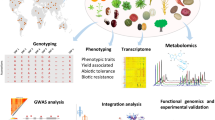Summary
We investigated random amplified polymorphic DNA (RAPD) in 27 inbred barley lines with varying amounts of common ancestry and in 20 doubled-haploid (DH) lines from a biparental cross. Of 33 arbitrary 10 base primers that were tested, 19 distinguished a total of 31 polymorphisms. All polymorphisms were scored as dominant genetic markers except for 1, where Southern analysis indicated the presence of two codominant amplification products. The inheritance of 19 RAPD polymorphisms and one morphological trait was studied in the DH lines. There was no evidence for segregation distortion, but a group of four tightly linked loci was detected. The frequencies of RAPD polymorphism in pairs of inbred lines were used to compute values of genetic distance (d), which were compared to kinship coefficients (r) between the same pairs of lines. A linear relationship between r and d was evident, but low values of r gave poor predictions of d. Cluster analysis showed that groups of inbred lines based on r were similar to those based on d with some notable exceptions. RAPD markers can be used to gain information about genetic similarities or differences that are not evident from pedigree information.
Similar content being viewed by others
References
Baum BR, Bailey LG, Thompson BK (1985) Barley register. Agric Canada Publ 1783B, Ottawa, Canada
Cox TS, Murphy JP (1990) The effect of parental divergence on F2 heterosis in winter wheat crosses. Theor Appl Genet 79:241–250
Cox TS, Kiang YT, Gorman MB, Rodgers DM (1985a) Relationship between coefficient of parentage and genetic similarity indices in the soybean. Crop Sci 25:529–532
Cox TS, Lookhart GL, Walker DE, Harrell LG, Albers LD, Rodgers DM (1985b) Genetic relationships among hard red winter wheat cultivars as evaluated by pedigree analysis and gliadin polyacrylamide gel electrophoretic patterns. Crop Sci 25:1058–1063
Delannay X, Rodgers DM, Palmer RG (1983) Relative genetic contributions among ancestral lines to North American soybean cultivars. Crop Sci 23:944–949
Dilday RH (1990) Contribution of ancestral lines in the development of new cultivars of rice. Crop Sci 30:905–911
Echt CS, Erdahl LA, McCoy TJ (1992) Genetic segregation of random amplified polymorphic DNA in diploid cultivated alfalfa. Genome 35:84–87
Graner A, Jahoor A, Schondelmaier J, Siedler H, Pillen K, Fischbeck G, Wenzel G, Herrmann RG (1991) Construction of an RFLP map of barley. Theor Appl Genet 83:250–256
Heun M, Kennedy AE, Anderson JA, Lapitan NLV, Sorrells ME, Tanksley SD (1991) Construction of a restriction fragment length polymorphism map for barley (Hordeum vulgare). Genome 34:437–447
Hu J, Quiros CF (1991) Identification of broccoli and cauliflower cultivars with RAPD markers. Plant Cell Rep 10:505–511
Kasha KJ, Kao KN (1970) High frequency haploid production in barley (Hordeum vulgare L.). Nature 225:874–876
Knauft DA, Gorbet DW (1989) Genetic diversity among peanut cultivars. Crop Sci 29:1417–1422
Lefort-Buson M, Dattée Y, Guillot-Lemoine B (1987) Heterosis and genetic distance in rapeseed (Brassica napus L.): use of kinship coefficient. Genome 29:11–18
Malécot G (1948) tLes mathématiques de l'hérédité. Masson & Cie, Paris
Mantel N (1967) The detection of disease clustering and a generalised regression approach. Cancer Res 27:209–220
Martin JM, Blake TK, Hockett EA (1991) Diversity among North American spring barley cultivars based on coefficients of parentage. Crop Sci 31:1131–1137
Melchinger AE, Messmer MM, Lee M, Woodman WL, Lamkey KR (1991) Diversity and relationships among U.S. maize inbreds revealed by restriction fragment length polymorphisms. Crop Sci 31:669–678
Nei M (1972) Genetic distance between populations. Am Nat 106:283–292
North American Genome Mapping Project (1991) An RFLP map of barley. In: Munck L (ed) Barley Genetics VI, Proc 6th Int Barley Genet Symp, Vol I. Helsingborg, Sweden, pp 245–247
Rogers JS (1972) Measures of similarity and genetic distance. Studies in genetics VII. University of Texas Publ 7213, pp 145–153
SAS (1987) SAS/STAT guide for personal computers. Version 6 edn. SAS Institute, Cary, N.C.
Selden RF (1991) Unit 2.9. Southern blotting and hybridization. In: Ausubel FM, Brent R, Kingston RE, Moore DD, Seidman JG, Smith JA, Struhl K (eds) Current protocols in molecular biology. J. Wiley & Sons, New York, pp 2.9.1–2.9.10
Singh SP, Nodari R, Gepts P (1991) Genetic diversity in cultivated common bean: I. Allozymes. Crop Sci 31:19–23
Southern EM (1975) Detection of specific sequences among DNA fragments separated by gel electrophoresis. J Mol Biol 98:503–517
Souza E, Sorrells ME (1989) Pedigree analysis of North American oat cultivars released from 1951 to 1985. Crop Sci 29:595–601
St Martin SK (1982) Effective population size for the soybean improvement program in maturity groups 00 to IV. Crop Sci 22:151–152
Suiter KA, Wendel JF, Case JS (1983) LINKAGE-1: a PASCAL computer program for the detection and analysis of genetic linkage. J Hered 74:203–204
Thompson DM, Chalmers K, Waugh R, Forster BP, Thomas WTB, Caligari PDS, Powell W (1991) The inheritance of genetic markers in microspore-derived plants of barley Hordeum vulgare L. Theor Appl Genet 81:487–492
Welsh J, McClelland M (1990) Fingerprinting genomes using PCR with arbitrary primers. Nucleic Acids Res 18:7213–7218
Williams JGK, Kubelik AR, Livak KJ, Rafalski JA, Tingey SV (1990) DNA polymorphisms amplified by arbitrary primers are useful as genetic markers. Nucleic Acids Res 18:6531–6535
Author information
Authors and Affiliations
Additional information
Communicated by G. E. Hart
Rights and permissions
About this article
Cite this article
Tinker, N.A., Fortin, M.G. & Mather, D.E. Random amplified polymorphic DNA and pedigree relationships in spring barley. Theoret. Appl. Genetics 85, 976–984 (1993). https://doi.org/10.1007/BF00215037
Received:
Accepted:
Issue Date:
DOI: https://doi.org/10.1007/BF00215037




